Gardenia Bush
Gardenia jasminoides
With the ultimate in fragrant flowers, a gardenia bush is one of South Florida's most beloved plants...though it can be a challenge to grow.
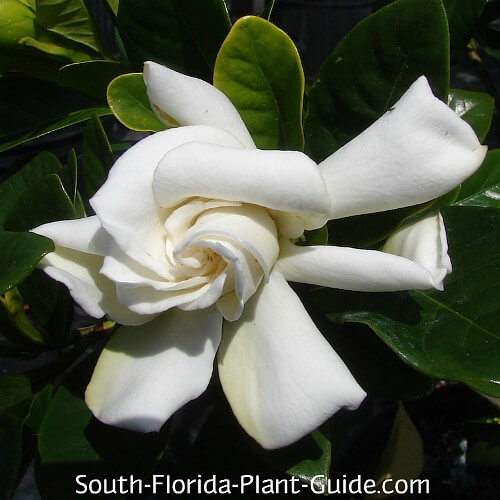
These plants flower profusely (more so as they mature) in spring and early summer (usually March through June), and then bloom on and off the rest of the warm months of the year.
Plant where you'll be able to enjoy their heavenly aroma, but, as with all heavily fragrant plants, don't over-do it.
A large hedge of these wonderful shrubs may be too much to bear for some people when the plants are blooming madly.
The luscious scent of gardenias has made them a classic favorite all
over the world for corsages and cut flowers, and having one of these
fragrant shrubs in the yard is often a dream come true for newcomers to
South Florida.
But there are important things to know about growing gardenias before you run out and buy one.
This
is not meant to scare you. These shrubs are not impossible to
grow...they're just picky about certain aspects of their environment.
So
the more you know about gardenia care, the better prepared you'll be to
grow them successfully to enjoy for many years to come.
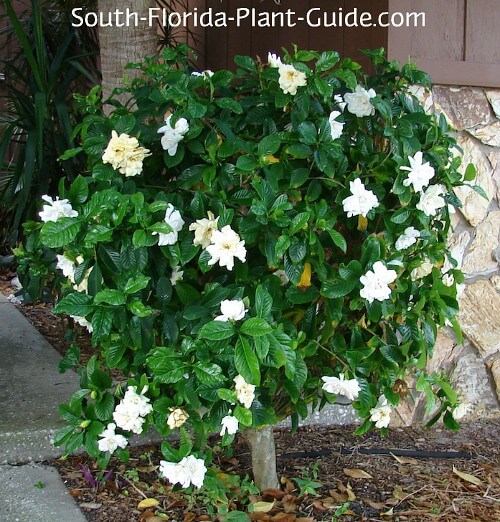
Placement
For acid loving plants like these (and azaleas, as well), placement is the key to success.
Gardenia bushes cannot take alkalinity in the soil without incurring nutritional problems.
They do best when planted away from concrete foundations and walkways where concrete will leach into the soil.
Areas with a pH of 7 or above (often from shell or natural limestone) will make it a struggle for you keep the plant happy and healthy.
You
may want to have the area where you want to plant tested for pH before
you purchase a gardenia. The ideal pH for these shrubs is between 5 and
6.5.
Call your county's extension office for testing info.
And don't even think of planting a gardenia near the beach - it's extremely salt sensitive, so you're just asking the plant to commit suicide.
Pests
Bugs seem to love these plants almost as much as we do. You'll want to check regularly for any signs of insect activity...aphids, mealybug, scale, whitefly are all fond of gardenias.
Sooty mold is very common and it's often the first indication you'll notice that insects have taken a liking to your gardenia bush. The mold is a blackish residue that forms on the leaves, and indicates your shrub has a pest problem (the mold forms on the secretions of insects).
See the section on Plant Problems for more information on plant pests.
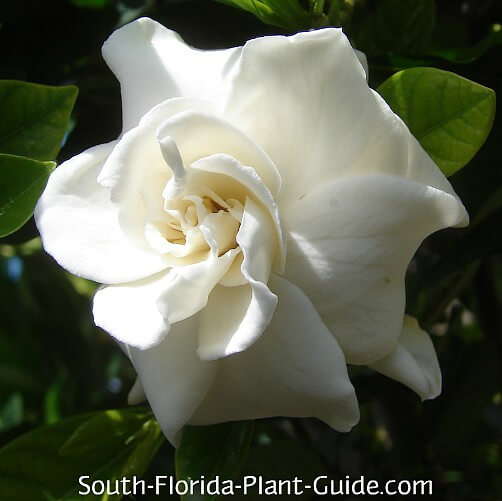
Other tips
These shrubs need regular irrigation. Too much or too little stresses the plant, inviting pests.
You may experience bud drop - where buds form but drop off before opening. This can be a water or a pest issue.
Bright yellow leaves are another common symptom on these plants and can indicate too much water or a reaction to cold temperatures...or the leaves are just old and about to fall off.
Gardenia bushes have special nutritional needs, too - see the Plant Care section below.
Other than all that - easy peasy!
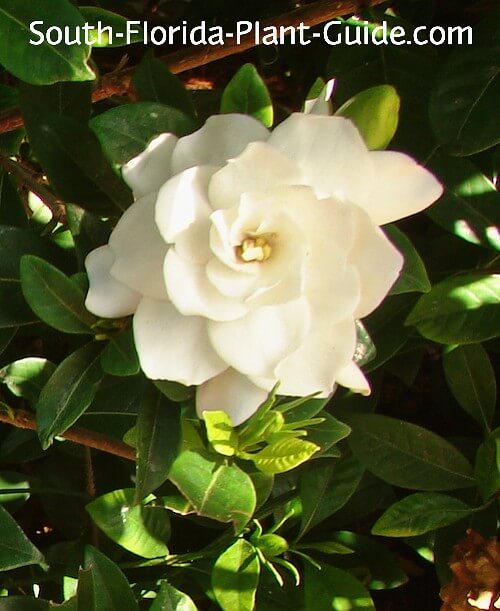
I can almost smell the heavenly perfume just from looking at pictures. It's an incredible scent that stays with you, that says, "Close your eyes and take a deep breath!"
Plant specs
These shrubs vary in size by variety.
Most are larger plants, like the popular Miami Supreme, that can be kept about 4 to 5 feet tall by 4 feet wide, though some dwarf gardenias are available that only grow to about 2 feet.
Some cultivars like Veitchii are full-size shrubs that have smaller blossoms and leaves.
You can also grow gardenias in tree form (buy one already trained) and let them get 8 to 10 feet, if you want.
They're
generally fast growers that take full sun to partial shade, and do best
in Zone 10. They are evergreen unless winter is harsh, causing the
plant to drop some leaves.
Buy a grafted plant (usually all gardenias sold in nurseries are grafted) to avoid nematodes, which feed on the shrub's roots.
A gardenia bush is considered deer-resistant, though there are no guarantees.
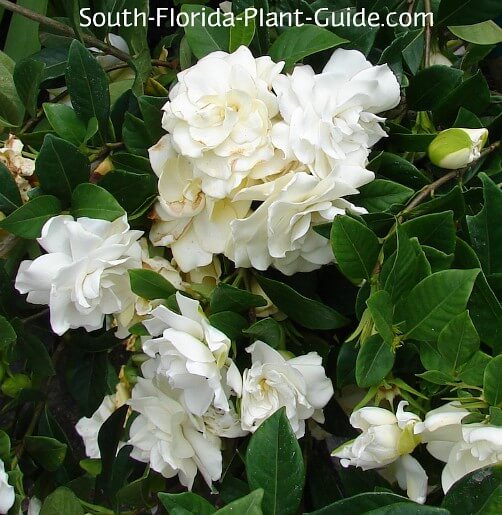
Plant care
Add top soil (or organic peat moss) mixed with composted cow manure to the hole when you plant. Handle the rootball gently during planting.
Trim back after the heaviest bloom period is over.
Water on a regular basis...letting the plant dry out a bit between waterings. Avoid keeping it too wet or letting it go too dry. This can cause flower buds to drop, yellow leaves or fungus and insect problems.
Fertilize twice a year with granular fertilizer specially formulated for gardenias and azaleas - with numbers like 7-0-8. Apply after the heavy spring/summer bloom and again in fall before October 1st.
During the time when using granular is a no-no, your plant might show nutritional-deficiency signs of overall yellowing. Apply EME (Essential Minor Elements).
Plant spacing
Most varieties will grow big and fat so place them 3 feet apart, though dwarf varieties can go 2 feet apart.
Come out from the house 2-1/2 to 3 feet. If placing along a walkway (non-concrete) come in 3 feet. By a doorway, place 3 feet away to allow for future growth.
A gardenia bush does fine in a large container - as long as you can get the hang of when to water.
Landscape uses for gardenia bush
- accent for a mixed bed
- single yard specimen
- plant for the corner of the house
- backdrop for smaller plants
- entryway accent
- by the lanai or patio
GOOD SNOWBIRD PLANT? NO
COMPANION PLANT SUGGESTIONS: Pair with foxtail fern, Xanadu philodendron, star jasmine, dwarf tibouchina, Maui ixora, Aztec grass, snowbush, dwarf powderpuff, and angel's trumpet.
Other plants you might like: Night-blooming Jasmine, Cape Jasmine
Take a break!
The ultimate guide to low-maintenance plants
and landscaping!
An ebook by
Chase Landre
author of
South-Florida-Plant-Guide.com
Learn more!
Get a greener thumb!
Want to learn more about South Florida planting, watering, fertilizing and dealing with weeds and pests?
See our Gardening How-To section for answers!
Get instant curb appeal!
An ebook by
Chase Landre
author of
South-Florida-Plant-Guide.com
Learn how to get instant curb appeal with fast growing plants and landscaping techniques!

